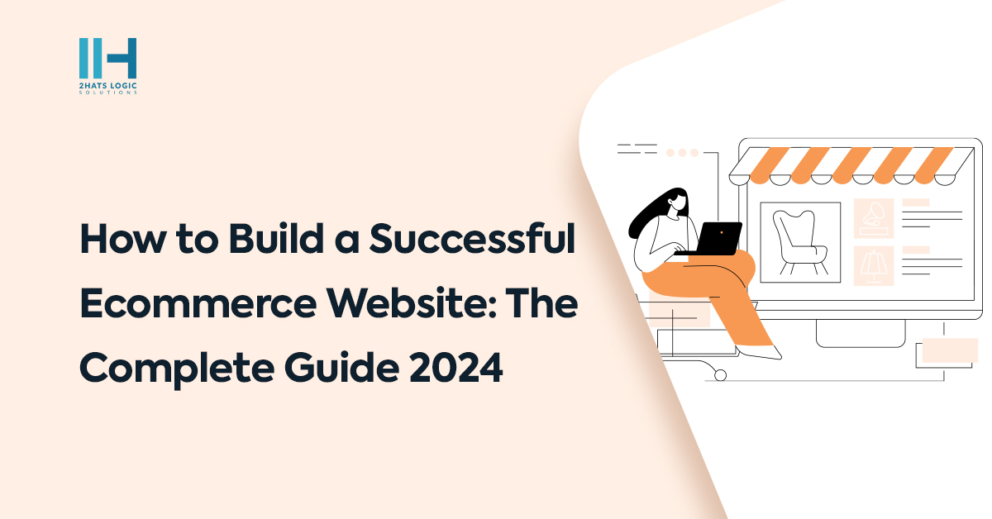Greetings! I'm Aneesh Sreedharan, CEO of 2Hats Logic Solutions. At 2Hats Logic Solutions, we are dedicated to providing technical expertise and resolving your concerns in the world of technology. Our blog page serves as a resource where we share insights and experiences, offering valuable perspectives on your queries.

Online shopping is more than just a trend; it’s a revolution. It’s changing the way people buy and sell things, and it’s opening up new possibilities for businesses of all sizes. But to succeed in this digital world, you need more than just a website. Whether you’re a seasoned entrepreneur or just dipping your toes into the online market, a well-designed e-commerce website serves as your digital storefront.
Building an e-commerce website can be challenging, but it can also be rewarding and profitable. As we look ahead, the significance of establishing a robust online presence becomes even more evident. By 2026, a striking 24% of retail purchases are expected to take place online. This statistic underscores the accelerating shift toward digital commerce and emphasizes the need for businesses to adapt to this evolving landscape.
Let’s take a deep dive into the process in this blog.
What is ecommerce Website Development?
E-commerce website development is the process of creating online stores where businesses can sell their products or services over the Internet. It involves designing and building a website that allows customers to browse through products, add them to a virtual shopping cart, and securely complete the purchase through online payment methods.
Steps to Develop an ecommerce Website
Take a look at how to develop an ecommerce website.
Define Your Goals
As a first step clearly articulate the purpose of your e-commerce business. Then specify the types of products or services you plan to sell and identify your target audience.
Choose a Domain Name and Hosting
Selecting a domain name that reflects your brand and is easy to remember is vital. Additionally, choose a reliable web hosting provider to ensure that your website is accessible to users without interruptions.
Select an E-commerce Platform
Choose an e-commerce platform that aligns with your business needs. Consider factors such as ease of use, available features, scalability, and compatibility with your products or services. Popular options include Shopify, Shopware, WooCommerce (for WordPress), Magento, and others.
Design Your Website
Invest time in creating a user-friendly and visually appealing design. A responsive design ensures that your website functions seamlessly across various devices. The first impression matters and design should encourage visitors to explore your store.
Add Product Listings
Develop detailed product listings that provide potential customers with all the information they need. Include high-quality images, comprehensive descriptions, pricing details, and any other relevant specifications. A well-organized product catalogue makes it easier for users to find and choose products.
Set Up a Shopping Cart and Checkout System
Implementing a reliable shopping cart and a streamlined checkout process is crucial for converting visitors into customers. Integrate a secure payment gateway to facilitate smooth and secure online transactions, accommodating various payment methods.
Implement Security Measures
Prioritize the security of your customers’ data. Implement SSL certificates to ensure encrypted communication and follow industry best practices for securing online transactions. Establishing trust is essential for the success of any e-commerce venture.
Enable User Accounts
Provide users with the option to create accounts on your website. User accounts enhance the shopping experience by allowing customers to track their orders, save favourite items, and expedite the checkout process for return visits.
Optimize for SEO
Implement search engine optimization (SEO) best practices to enhance your website’s visibility on search engines. This includes using relevant keywords, optimizing product descriptions, creating a sitemap, and employing other strategies to improve your search engine ranking.
Test Your Website, Launch, and Market
Conduct thorough testing to identify and rectify any bugs or usability issues. Once confident, launch your website to the public. Develop a comprehensive marketing strategy using channels such as social media, content marketing, and email campaigns to drive traffic to your site. Continuously monitor your website’s performance, gather user feedback, and adapt your strategy to ensure long-term success.
Benefits of Ecommerce Website Development
In the current digital era, e-commerce website development has grown in significance for store owners. Check out the benefits of online store creation and how businesses can reach a larger audience, boost sales, and enhance customer service.
Open 24/7
Unlike physical store online store does not have any time barriers. An e-commerce website is available to customers 24/7. This means customers can shop from your store anytime, anywhere, which can help to increase sales.
Cost Effective
An e-commerce website can be a more cost-effective way to run your business than a traditional brick-and-mortar store. You won’t need to pay for rent, utilities, or staff to operate an online store.
Improved Customer Service
An e-commerce website can help you improve your customer service by providing customers with a convenient way to contact you, track products and get answers to their questions.
Global Reach
An e-commerce website allows you to sell your products to customers all over the world. This is a great way to expand your business and reach new markets.
Factors to Consider when Choosing an Ecommerce Platform
Ease of Use
Opt for an ecommerce platform with an intuitive interface for both store management and a seamless customer experience. A user-friendly platform streamlines operations and enhances overall usability.
Scalability
Choose a platform that can grow with your business. Ensure it can handle an increasing number of products, transactions, and users without compromising performance, providing scalability for future expansion.
Security
Make sure your platform prioritizes security with SSL certification and secure payment gateways. This is crucial for building trust and ensuring the integrity of your online transactions, promoting secure online transactions and protecting customer data.
Mobile Responsiveness
In the era of mobile shopping, select a platform that offers responsive design. This ensures your ecommerce site functions seamlessly on various devices, meeting the expectations of users who prefer mobile access.
Integration with Third-Party Tools
Look for a platform that easily integrates with essential third-party tools and services, such as accounting software, marketing platforms, analytics tools, and shipping solutions. Smooth integration enhances overall business efficiency.
Final Thoughts
In conclusion, choosing the right ecommerce platform is a pivotal decision that can significantly impact the success of your online business. By carefully considering factors such as ease of use, scalability, security, mobile responsiveness, and integration capabilities, you pave the way for a seamless and trustworthy online shopping experience.
Remember, your choice of an e-commerce platform and ecommerce web developer plays a vital role in shaping your brand’s online presence and establishing a solid relationship of trust with your customers. So, take the time to assess your specific business needs, weigh the options among various e-commerce services, and collaborate with a skilled ecommerce web developer to make an informed decision that aligns with your long-term goals.
FAQ
Why is it essential to have an e-commerce website for my business?
In the digital era, an e-commerce website opens up your business to a global audience, operates 24/7, and provides a cost-effective way to reach customers. It enhances customer service, allowing for convenient communication and tracking, ultimately boosting sales and expanding your market reach.
How do I choose the right e-commerce platform for my business?
Consider factors such as ease of use, scalability, security features, mobile responsiveness, and integration capabilities when choosing an e-commerce platform. Assess your business needs and align them with the platform that best supports your long-term goals.
What security measures should I implement on my e-commerce website?
Prioritize customer data security by implementing SSL certificates for encrypted communication. Choose a platform with secure payment gateways and follow industry best practices to ensure the integrity of online transactions. Building trust through robust security measures is crucial for the success of your e-commerce venture.
How can I optimize my e-commerce website for search engines (SEO)?
Implement SEO best practices such as using relevant keywords, optimizing product descriptions, creating a sitemap, and employing other strategies to improve your website's visibility on search engines. Enhanced SEO ensures that potential customers can easily find your products and services online.
What role does user experience play in the success of an e-commerce website?
User experience is crucial for the success of an e-commerce website. Invest time in creating a user-friendly and visually appealing design. Ensure your website is responsive across various devices, implement a streamlined checkout process, and offer features like user accounts to enhance the overall shopping experience. A positive user experience encourages repeat visits and builds customer loyalty.

Related Articles





